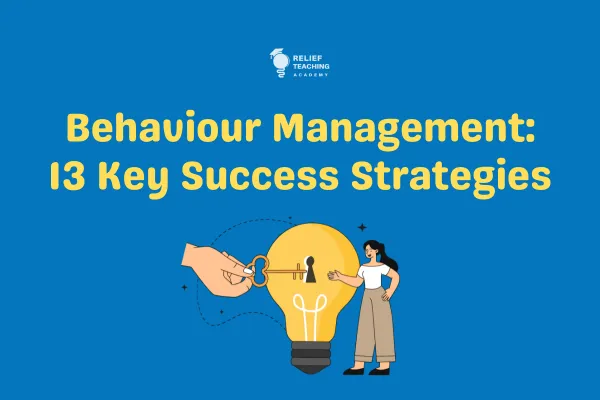Latest Academy Blogs
Select article category or search for specific article:

Behaviour Management: 13 Key Success Strategies
Your behaviour, as the relief teacher, is the single most influential impact on the behaviour of the students in your classroom. You have a huge impact on how your day will go. There are a couple of MUST DO strategies that will help your day run smoothly.
#1 Anticipate compliance –
Generally, most students want to behave and very few really want the tension of getting into trouble. So if you give instructions, anticipate that the student will comply and act as if this is the case.
For example, in your travels around the room, you notice Gina is reading a book and not doing her Math. Ask Gina to close the book and continue to move around the room as if you know Gina is going to comply.
Gina feels your expectation and 99.9% of the time she will comply because she is not going to get any mileage if she doesn’t. You have already moved on!
Consider the alternative action. You say the same thing, but stand at Gina’s desk with arms on your hips and a snarl ready on your lips. You’re ready for a fight and Gina is likely to accommodate you.
#2 Boost compliance by framing requests with positive expectations –
Phrase your request with an expectation of compliance. For instance, say, "Paul, thank you for closing the windows." or “Thanks for putting that book away, Gina.” This manner of expression increases the likelihood of students complying with the request.
#3 Differentiate discipline from managing behaviour –
Relief teachers seem to take things to heart far too often. Learn to differentiate between discipline and behaviour.
Discipline is a belief system of values and principles. Children learn that at home. Discipline involves the principles of honesty, fairness and the values of integrity and personal accountability amongst many more.
Teachers don’t discipline students, we manage their behaviour. Parents are still accountable (not teachers) if their child breaks the law, or damages property.
Society dumps on teachers far too easily.
So... don’t reach for the bottle just yet. Ahh heck - go for it anyway!
#4 Stop on my SIGNAL –
Do the class know when you want their attention? Avoid screaming, “Listen Now!.” because as a relief teacher, the class is not attuned to your voice. Try other options like a small bell, clap of hands, or a silly bike horn. Experiment with different techniques that will work for you.
Whatever you use, it is important to have a STOP SIGNAL at your disposal.
#5 Disregard the secondary behaviours –
Secondary behaviours are those that occur when you have a discussion with the student and the student wants to take control.
They are 'chase me' behaviours designed to push your buttons, gain furious responses and ultimately distract you from the purpose of the discussion.
Some kids are masters at it, having practised it very well at home.
OK. So you want Freddie (it’s a shame that, statistically, most of the offenders are boys) to leave the room. You have exhausted all of your positive reinforcement, redirection techniques, warnings and sanctions and need him to leave.
The secondary behaviours are the chair being thrown back, stamping, general huffing and puffing posturing. Freddie is building up a real performance for the benefit of his classmates.
He may want to divert the conversation away from the original behaviour or try to encourage a confrontation
Don't allow him to take control of your behaviour. Resist the temptation to address the secondary behaviours at the moment. Instead, remember them for later.
There is little doubt that Freddie will eventually leave and when he has left the room, he has followed your instructions. The dramatic trail of disruption that he has left in his wake can be dealt with later. Your calm and considerate response will be watched by the class and they will be impressed by your confidence, even in those emotionally fuelled moments.
The class will slowly learn that these misbehaviour will not work with you.
Job well done!
#6 Keep your instruction DIRECT –
Major long-term studies have proven the irrefutable success of direct instruction (now called explicit teaching)
The term refers to a method for teaching that is fast-paced and provides constant interaction between students and the teacher.
I’m old – very old. So I can remember direct instruction well. I was taught by this method and I taught using this method. It was the staple of my teaching repertoire. Direct Instruction is rich in structure and drilling and content. It is starting to become more popular given the current drive for proven results.
Many studies have proven its success as a teaching strategy.
What does it mean for the Relief Teacher and how do you DO it
Direct instruction is a sequence of supports:
setting a purpose for learning
telling students what to do
showing them how to do it
guiding their hands-on application of the new learning.
Direct instruction begins with setting the stage for learning, followed by a clear
explanation of what to do (telling), followed by modelling of the process (showing), followed by multiple opportunities for practice (guiding) until students can participate independently. Direct instruction moves from a situation where the teacher has HEAVY input to where students have full responsibility with minimal teacher involvement.
#7 Avoid going for the throat FIRST! –
As hard as it might prove to be, don’t go for the throat first.
Start with the non-intrusive strategies
You might have to take a few deep breaths first. You do remember that World Was One started with one shot.
I have sometimes been caught out by not making a concerted effort to get all the facts first.
#8 Distract - Diffuse - Disperse –
The truth of the matter is that sometimes you are going to be confronted with a disagreement between students. This can happen within metres of a teacher.
Here is a simple strategy that (usually) works.
Firstly, DISTRACT students from hurting or hitting - whatever is occurring. This might be a whistle or calling out. (Water on the fighting dogs!) The aim is to get the offenders to focus on you, not each other. (“I’m here gentlemen/ladies. Look at me!" - repeat this calmly.) If you can use humour, now is a good time to apply it. If not - DON’T.
Never get in the middle no matter how big you are.
Secondly, DIFFUSE the anger by NOT being angry yourself. (Riots develop when both sides are angry.) Avoid shouting or panicking. Be calm - at least sound calm. Keep your directions short and clear. Never give more than ONE direction at a time.
"Bill, thanks for standing over there. John, thanks for putting your hands down." Repeat if necessary but do not change the directions. “OK. Let’s sit down and face opposite directions." Having students sit on the ground really has a calming effect. (Watch what NYPD do). and then handcuff them to the nearest pole.
Thirdly, DISPERSE. You only need the offenders. Chase the watchers away. (Move on citizens. Nothing to see here)
The next step depends on your level of authority. If you are comfortable dealing with the offenders at this point, then do it. I suggest if you are a relief teacher you probably need to pass the offenders over to someone.
Now... that is another article!
#9 Use the assertive “I message” –
These I-messages are expressions of our feelings. Thomas Gordon, creator of Teacher Effectiveness Training (TET), tells us these messages in three parts. First, include a description of the child’s behaviour. “When you talk while I talk...” Second, relate the effect this behaviour has on the teacher.
“...I have to stop my teaching...” And third, let the student know the feeling
that it generates in the teacher. “...which frustrates me.”
A teacher, distracted by a student who was constantly talking while he tried to teach, once made this powerful expression of feelings: “I cannot imagine what I have done to you that I do not deserve the respect from you that I get from the others in this class. If I have been rude to you or inconsiderate in any way, please let me know. I feel as though I have somehow offended you and now you are unwilling to show me respect.”
The student did not talk during his lessons again.
#10 Never make it PERSONAL –
If an important goal is for our students to treat each other with respect, then the responsibility for modelling respectful communication is on you.
Words can be very powerful. Be careful how you use them.
Be sure that your words focus on the behaviour not on the student. There is a very big difference between saying, "You are so lazy!" and, "You haven't done
your homework."
Teacher remarks should be about behaviours. Students should know you value them even when you have to address areas that need improvement.
It is important to remember that some of our students will test us to see if we
can maintain our respectful attitude even after they push our buttons. Never
personalise students' remarks or behaviour.
Always remember that often the child who acts like they need approval the least is the one who needs it the most.
#11 Model behaviour –
Kids love double standards. A teacher yelling at a student for yelling in the playground just doesn’t make sense.
Make no mistake, you are on show. The students want to see how you solve conflict. They will often use that as an exemplar.
#12 Know when to IGNORE –
Sometimes you have to learn to pick the battles. There is no good coming back
with, “We won the battle, General but we lost the war!”
Some relief teachers (and some teachers) target the most trivial matters which
are blown out of all proportion.
Cops in Australia now have to halt car pursuits when it seems the risks outweigh the rewards.
So if a shirt is not tucked in or a paper has been thrown to the floor, give it the
due weight it deserves.
#13 Direct the learning to the offender –
Sometimes you have to learn to pick the battles. There is no good coming back
with, “We won the battle, General but we lost the war!”
Some relief teachers (and some teachers) target the most trivial matters which
are blown out of all proportion.
Cops in Australia now have to halt car pursuits when it seems the risks outweigh the rewards.
So if a shirt is not tucked in or a paper has been thrown to the floor, give it the
due weight it deserves.
Want to learn all the 50 incredible tips to transform your classroom experience?
Click on this link now 👉 50 Effective Teaching Strategies for Casual Teachers

CLICK HERE to find out more about joining the Relief Teaching Academy
Subscribe to get up to date tips, strategies, resources and guidance on all things relief teaching.
Relief Teaching Academy is a service of EPC Capital Pty Ltd.
© Copyright 2023. EPC Capital Pty Ltd. All rights reserved.
Send us a message

